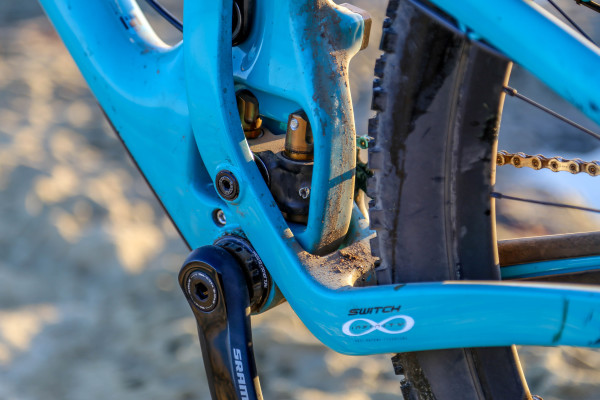Built around an aggressive geometry and a new suspension platform dubbed Switch Infinity, the Yeti SB5C is one of the most anticipated new trail bikes of 2015. It replaces the Yeti SB75, the company’s first attempt at a from-the-ground-up 650B model, which received lukewarm reviews when it was launched last year.
Designed to tread the middle ground between trail and enduro, we’ve had the opportunity to abuse the new bike on our home trails. Has it lived up to the hype so far?
The Yeti Sb5c is available as frame only for $3,399. There are four different complete options that start at $4,999. Additional factory upgrades include $350 for a Thomson Dropper Post, and a $2,400 upcharge for ENVE carbon wheels.
Our demo was kitted with an X01 level kit and retails for $6,599. From the Thomson stem, Easton Haven Carbon Bars, 11 speed drivetrain, and Shimano XT brakes, there’s nothing here we wouldn’t consider spec’ing on one of our personal bikes.
The medium size frame has a generous 23.6″ top tube, so we swapped in a 50mm stem for more aggressive handling.
The brake and drivetrain cable routing is external, but the frame has provisions for internal dropper post routing. The one prospective issue we’ve noted is that as the suspension cycles the rear brake cable gets wedged between the linkage and frame. It does not appear to be causing any wear, but we’ll continue to keep an eye on it.
Down below, the carbon frame is protected by a custom guard. This is also the sole location for water bottle mounts. It’s not ideal, but it get’s the job done.
The heart of the new bicycle is the Switch Infinity system. While the casual observer might assume it’s a dual shock due to the Kashima coating, it’s actually the natural evolution of the 303 rail system. As the suspension cycles through its travel, the main pivot moves upward, to produce more anti squat for better pedaling performance. As the bike moves further into its travel, the pivot moves downwards to reduce the impact of chain forces on the suspension performance.
Pushing up and down on the suspension, it doesn’t appear that the linkage moves significantly, but its flat out rad on the trail. We’ve been rallying the bike for over a month and never once bothered to clean it – yet the frame hasn’t complained.
Tyler has been beating on a preproduction Thomson Dropper post for over a year without any issues, and only complaint thus far is that the return speed is a little slow.
For a bike with such an aggressive geometry, Yeti made some interesting choices with tire spec. The company wrapped the DT Swiss wheels in a 2.4″ Ardent up front and a 2.2″ Ikon in the rear. This tire pairing is on the XC end of the trail spectrum and didn’t survive the first ride. Only a few minutes in, our test rider managed to put a rock clear through the rear tire.
The Yeti SB5C is a burly 160mm bike stuck in the body of a 127mm trail bike. With a spacious top tube and generous 17.4″ chainstays, it’s an incredibly stable platform that begs to be ridden faster. Coupled with the slack 67 degree head tube angle, it can be a handful to pilot around tight technical sections, but truly comes into it’s own at high speeds.
The rear suspension has a lively platform that strikes the delicate balance between being plush off the top, and ramping up smoothly, without bottoming out harshly. Even if you can’t exactly wrap your head around why it works mechanically, it more than performs on the trail.
Compared to the majority of other bikes in this category, the SB5c is built along more aggressive lines, but it maintains its composure when pointed both up and downhill. We’ve ridden it almost exclusively in descend mode, and experienced minimal pedal bob.
Stay tuned early next year for our long term impressions of the bike!








